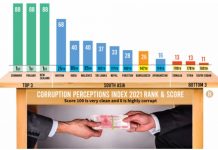Introduction
Bangladesh Prime Minister Sheikh Hasina finally opened the Padma Bridge on June 25, 2022, after the completion of eight years of construction work.
Built with the state-of-the-art technology, the Padma Bridge is the world’s 122nd largest multipurpose bridge over the country’s mighty “sea-like” Padma River. The bridge’s underwater pilings extend 122 meters deep, a world record, and it required 41 support pillars. At some points in the river the water flow volume ranks second globally only after the Amazon River.
By connecting the capital city, Dhaka, with 21 South-Western districts, the Padma Bridge will work as a direct gateway to the country’s economically backward South-Western region and will significantly reduce travel time. Recent newspaper articles have reported that fresh fish and other perishable goods now reach Dhaka in just 6 hours, cutting the travel time in half.
The Economics of the Padma Bridge
1) Was the US$3.9 billion cost too high?
Arguments costs were too high:
- The World Bank claims that Bangladesh has the highest infrastructure costs in the world. Bangladesh awarded the contract to a single bidder, that is, China Major Bridge Engineering Company, Ltd., when other bidders refrained from submitting full quotation (project bids).
- India’s 9.0 km Bhupen Hazarika’s Bridge cost only US$156 million. At this rate, it was possible to build 30 Bhupen Hazarika bridges in India at the cost of one Padma Bridge. The Crimean Bridge, built in three years at a cost of US$3.69 billion across the Kerch Strait, with a similar pile depth (to the Padma Bridge) but three times as long (18.1 kilometres)
Arguments costs were not too high:
- There are bigger bridges in the world than the Padma Bridge, but there is no bridge over a sea-like Padma River. For river training alone, Bangladesh had to spend more than US$1 billion, which added to the cost.
- The bridge’s construction budget increased threefold from its initial US$1.2 billion. This was due to delays in the construction work that led to a substantial cost overrun of the project scheme. The delayed construction work began in November 2015 and the bridge was belatedly opened to traffic in June 2022.
2) The alleged corruption
The World Bank had initially intended to finance the Padma Bridge project with a US$1.2 billion concessional credit. However, the bank pulled out in June 2012 citing corruption concerns. Two SNC-Lavalin executives were charged in Canada but after the court excluded wiretap evidence, the prosecution withdrew and the case was dismissed by the court.
Assuming corruption did take place and bribes changed hands in the construction of the Padma Bridge, one of two factors would have likely ensued. Instead of mis-allocation of economic resources, there was transfer of economic resources from the government sector to the private sector. Thus, there was no net loss.
3) Asian Development Bank’s Benefit-Cost Analysis
The Asian Development Bank (ADB) did a benefit–cost analysis in 2009 over a 30-year period (2011-2014) of the bridge. A real discount rate of 12% was used, reflecting the economic opportunity cost of capital in Bangladesh. The resultant economic internal rate of return (EIRR) for the proposed project investment is estimated at 20.0%. Since 20% EIRR exceeded the 12% real interest discount rate, consistent with the economics textbook theory, the ADB posited the proposed Padma Bridge to be economically viable.
4) The Padma Bridge’s US$3.9 billion in costs can be fully recouped sooner than later
The commissioning of the Padma Bridge is expected to increase the gross domestic product (GDP) of the economically distressed South-West region of Bangladesh by up to 2.5%, and the national GDP is projected to rise by 1.%.
The World Bank reported Bangladesh’s GDP was US$416 billion in 2021. As such, the estimate suggests that the Padma Bridge should generate US$4.9 billion (=1.2% of US $416 billion) annually such that the full amount of the cost of the project can be fully recouped sooner than later.
5) Public finance and the financing of the Bridge
The upper level of the Padma Bridge which cost around US$4 billion has been funded entirely through mobilisation of domestic resources. The project is a demonstration of how a low-income economy can successfully mobilise domestic resources to finance large-scale critical infrastructure projects.
6) Decentralisation of Dhaka and industrialisation of the South-Western districts
The capital city has become heavily centralised in terms of the public administration, and other business purposes. Dhaka is the densest city on earth, which has experienced a mammoth rural to urban migration, with concomitant sustainability crises, e.g., noise, pollution and traffic congestions. Industrialisation of South-Western parts of the country should likely occur and tourism should also flourish in the region, reducing out migration from the region and hence alleviating over-urbanisation of Dhaka and other major cities.
7) Benefits from expanded trade and commerce
Before the North American Free Trade Area (NAFTA) went into effect in 1994, Canada, Mexico and the United States did not have free trade. Although there were no “natural barriers”, like rugged mountains or turbulent rivers between these three juxtaposed countries, the existence of “economic barriers” like tariffs impeded free trade among these three countries. After 1994 when most of the tariffs were abolished, NAFTA members enjoyed low prices for their traded goods coupled with a higher standard of living.
In the case of Bangladesh, the sea-like Padma River acted as a “natural barrier” impeding the free flow of people, goods and services. Thus, the benefits accruing to the opening of the Padma bridge are analogous to the benefits emanating from free trade.
8) The Padma Bridge is the golden goose that has already started to lay golden eggs
- Vehicle Traffic & Tolls: On 2 July, 2022 the Times Business Standard reported that Friday, 1 July marked the highest amount of toll collection – Tk3,16,53,200 – from the Padma Bridge in a day since its inauguration on June 25, 2022. In the absence of alternative means of communication and a preference to traverse the 6.15 km distance within the shortest time, the demandto commute over the Padma Bridge is inelastic. Economics textbook suggests if tolls go higher, given the inelastic demand, it will generate more revenue for the government.
- The Patuakhali fishing industry gets a boost: Located on the Southern shores of the Bay of Bengal, Patuakhali, produces about 1.23 lakh tons of fish annually, of which 36,000 tons are consumed locally while the remainder is sold in different parts of the country. With the opening of the Padma Bridge, the direct and faster shipment of fish to other places of the country including Dhaka, have become feasible. They are also expanding their farming capacities in anticipation of higher demand, prices and profits.
- The Padma Bridge-Induced Economic Gains Can Be Distributed for All Purposes: Some critics have argued that instead of investing crores of taka of Bangladeshi taxpayers’ money for the construction of the Padma Bridge, it should have been spent on other social programmes, including pension and health. This proposition would negate economists’ long held view that investment in physical infrastructure including roads, highways and ports generate forward and backward linkages thus ushering in a meaningful economic development. Thus, investment in the construction of the Padma Bridge is good economics. The Padma Bridge-induced economic gains in the form of tolls and taxes can be utilised to finance necessary and additional social programmes.
The Implications of the Padma Bridge
1) The Hasina Government’s defiance of the World Bank in 2012 echoes the Mahathir Government’s rejection of the International Monetary Fund in 1997: As noted earlier, the World Bank cancelled the US$1.2 billion on corruption allegations centring the Padma Bridge. Other donor agencies including the ADB and Japan International Cooperation Agency (JICA) followed the suit.
Following the World Bank’s decision, the government of Bangladesh decided to fund the project from its very own fund. The Bangladesh government even rebuffed China’s proposal to build the bridge on a build-own-transfer (BOT) basis by investing US$2 billion or 70% of the project expense.
The Bangladesh’s decision to build the Padma Bridge highlights the most public and direct repudiation of the World Bank, in particular, and other donors in general. A similar episode happened in the mid-1960s when South Korea decided to build an express-way connecting Seoul – the capital – with Busan – the main port city. After the World Bank and other donors rejected the idea, Korea went ahead to complete the project on its own at half the time and a fraction of the cost (see Kim, Chung-yum, From Despair to Hope: Economic Policymaking in Korea 1945-1979. Seoul: Korea Development Institute, 2011).
2) Bangladesh’s Aid-Dependency Stigma Has Been Removed Forever; Creditors Are Now Proactively Considering to Loan Funds to Bangladesh: Bangladesh’s determination to build the Padma Bridge with its own domestic resources has removed forever the country’s “tarnished image of handouts dependency.”
Bangladesh has never reneged in its own loan payments to foreign debtors and international financial institutions. As such, Bangladesh’s international credit rating has been laudable. In addition, the “Do-It-Alone” Bangladesh’s strategy to fund the Padma River has reversed creditors’ perspective of Bangladesh. Creditors have now expressed interest to proactively extend loan to Bangladesh, instead of the other way round.
3) Potential exists for employment of Bangladeshi engineers overseas: A third of 4,000 engineers who were engaged in all elements of the Padma Bridge were Bangladeshis. They were able to acquire the highly and necessary technical skills from the state-of-the-art technology applied in the construction of the Padma Bridge. Newspaper accounts reveal that there are potentials for these Bangladeshi engineers to find employment abroad.
Here it is worth mentioning the South Korean example. The Seoul-Busan expressway, built in defiance of the World Bank and donors, not only spurred economic activities along the corridor of two major population centres, its construction was also a critical learning opportunity for people of the Republic of Korea. With the gained capacity, construction companies from South Korea were able to win major infrastructure projects in the Middle-East, which was a critical source of foreign exchange. Today, the Republic of Korea is regarded as a leader in infrastructure construction.
4) The Padma Bridge: An integration into the Asian Highway connectivity: The Asian Highway-1, connecting Assam with West Bengal of India via Sylhet-Dhaka-Narail-Jessore, had two missing links: the Padma Bridge and the Kalna Bridge in Narail. The commissioning of the Padma Bridge will now work as a key component for boosting economic growth of Asia and improving the country’s standing in the continent. The Padma Bridge will also pave the way for putting in place a new route for the Trans-Asian Railway (TAR) network. Connectivity is a critical factor for improved trade and commerce.
4) Capacity utilisation of existing physical infrastructures: Expanded connectivity outcome of the Padma Bridge should facilitate expanded utilisation of existing infrastructures in the country. For instance, Payra, Mongla and Benapole ports can be used with increased economic activities in the industrially lagging South-West.
7) The Padma Bridge and China’s Belt and Road Infrastructure – An example of altruist gesture or hidden motive? The Padma Bridge was built by the state-owned China Major Bridge Engineering Company, Ltd. and is seen by Beijing as a milestone for the China-Bangladesh cooperation. The Chinese state media portrayed it to be a part of the Belt and Road Infrastructure (BRI).
Viewed from this perspective, China’s BRI is: a) a neo-colonialstrategy to augment its foothold in South Asia by creating economic dependence, as it did in Sri Lanka, and b) a part of the same game to undermine India’s security and strategic interests. However, independent studies, such as done at London-based Chatham House and Sydney-based Lowey Foundation did not find any evidence of any such motive of China (see Jones, Lee, and Shahar Hameiri, Debunking the Myth of ‘Debt-trap Diplomacy’. How Recipient Countries Shape China’s Belt and Road Initiative. London: Chatham House, 2020; Vines, Alex, Creon Butler and Yu Jie, The Response to debt distress in Africa and the role of China. London: Chatham House, 2022; Rajah, Roland, Alexandre Dayant and Jonathan Pryk, Ocean of debt? Belt and Road and debt diplomacy in the Pacific. Sydney: Lowy Institute,2019)
Conclusion
Prime Minister Sheikh Hasina who oversaw and determined the construction of the US$3.9 billion project from the beginning to its end, aptly said the Padma Bridge is, “Bangladesh’s pride, honour and ability” during its commissioning on 25 June, 2022. The Padma Bridge now joins the ranks of the National Martyrs’ Memorial and the Sahid Minar, as monuments of our national consciousness.
The Padma Bridge will not only be able to generate enough revenue to recoup its costs but also will transform the economic landscape of the South-West region in particular and the country in general. Neighbouring countries will also reap the benefits of the Padma Bridge.
Fifty years since its inception, Bangladesh has successfully transitioned from a “Bottomless Basket to South Asian Economic Miracle” where the Padma Bridge has been a major building block.

Muhammad Faizul Islam obtained his Ph.D. in economics from Northeastern University, Boston, Massachusetts. He has twenty-five years plus of work experience with the U.S. federal government and has over four decades of university teaching experience. He also teaches at University of Maryland (Global Campus). He was an International Business Reviewer for The Wall Street Journal and a former Fulbright scholar. Dr. Islam received numerous awards for his professional accomplishments in the U.S. federal government and academia.






